

ANTHROPOLOGICAL PAPERS
OF THE
American Museum of Natural
History.
Vol. I, Part II.
SOME PROTECTIVE DESIGNS OF THE DAKOTA.
BY
CLARK WISSLER.
NEW YORK:
Published by Order of the Trustees.
February, 1907.
American Museum of Natural History.
PUBLICATIONS IN ANTHROPOLOGY.
The results of research conducted by the Anthropological staff of the Museum, unless otherwise provided for, are published in a series of octavo volumes of about 350 pages each, issued in parts at irregular intervals, entitled Anthropological Papers of the American Museum of Natural History. The Anthropological work of the Museum is organized under two heads. The Department of Ethnology exercises curatorial functions in ethnography, ethnology and physical anthropology and in all archæology except that pertaining to the present confines of Mexico and the Central American States which has been delegated to a distinct department entitled the Department of Archæology. This series of publications aims to give the results of field-work conducted by the above departments, supplemented by the study of collections in the Museum. The editorial responsibilities are administered by the Curator of the Department of Ethnology.
The following are on sale at the Museum at the prices stated.
| Vol. I. Part I. | Technique of some South American Feather-work. By Charles |
| W. Mead. Pp. 1-18, Plates I-IV, and 14 text figures. January, | |
| 1907. Price, $0.25. | |
| Part II. | Some Protective Designs of the Dakota. By Clark Wissler. |
| Pp. 19-54, Plates V-VII, and 26 text figures, February, 1907. | |
| Price, $0.50. |
ANTHROPOLOGICAL PAPERS
OF THE
American Museum of Natural History
Vol. I, Part II.
SOME PROTECTIVE DESIGNS OF THE DAKOTA.
By Clark Wissler.
| Introduction | |
| Shield-designs | |
| Ghost-dance Designs | |
| The Hoop | |
| The Whirlwind | |
| The Thunder | |
| The Spider | |
| Conclusion |
ILLUSTRATIONS.
Plates.
| V. | Model of a Shield, Museum No. 50-2929. Diameter, 39 cm. |
| VI. | Shield-design on a Cape, Museum No. 50-3102. Width of cape, 178 cm. |
| VII. | Model of a Shield, Museum No. 50-5467. Diameter, 46 cm. |
Text Figures.
| 1. | Shield-cover with Design |
| 2. | Shield-design, from a Drawing by a Native |
| 3. | Drawing, by a Native, of a Shield-cover |
| 4. | Shield-design, from a Drawing by a Native |
| 5. | Spider-design for a Shield, from a Drawing by a Native |
| 6. | Shield-design, from a Drawing by the Man who dreamed of it |
| 7. | Shield-design representing a Thunderstorm, from a Drawing by a Native |
| 8. | Model of a Shield with Pictographic Design |
| 9. | Design on Sioux Shield captured by a Fox Indian |
| 10. | Front of a Ghost-dance Garment |
| 11. | Back of Garment shown in Fig. 10 |
| 12. | Designs on the Front of Ghost-dance Garment |
| 13. | Designs on the Back of Garment shown in Fig. 12 |
| 14. | Front of a Ghost-dance Garment bearing Dragon-fly Design |
| 15. | Back of Garment shown in Fig. 14 |
| 16. | Circular Design upon a Shirt |
| 17. | Sketch, by a Native, of an Elk-mystery Dancer carrying a Hoop with a Mirror in the Centre |
| 18. | Engraved Metal Cross |
| 19. | Engraved Bone Object |
| 20. | Whirlwind Design, from the Handle of a Club |
| 21. | Whirlwind Design, from a Popgun |
| 22. | Whistle, of Bone |
| 23. | Design of a Spider-web |
| 24. | Sketch of a Robe for the Medicine-bow Owner |
| 25. | Design on a Metal Belt-ornament |
| 26. | Design of the Spider-web on a Straight Pipe |
The decorative art of the Dakota has been treated in a preceding paper, in which brief mention was made of religious art, or that art in which there was a definite, unmistakable motive on the part of the artist to represent mythical or philosophical ideas. In this more serious art, a large number of designs may be characterized as “protective designs,” because their presence or possession is in part a protection. The idea in a protective design seems to be a symbolical appeal to the source or concrete manifestation of a protective power. It is not easy to get the point of view and the spirit of the faith that make these designs significant, but from the detailed explanations of them some general idea can be formed. The descriptions given in this paper are based upon the statements of Indians, in most cases the executers of the designs. The attitude of the reader toward such a study as this is often that of concluding that the points of view set forth by a writer are universal in the tribe. This leads to a great deal of superficial criticism. In the opinion of the writer, any rejection of such study because one or two or several Indians deny all knowledge of some or all of the specific native accounts upon which conclusions are based, is absurd. We might as well test the artistic sense of a city by calling in one or two persons from the street. As a case in point, the reader is referred to the remarks of J. Owen Dorsey on the authenticity of Bushotter’s Double Woman.[1] A great deal of the information received from Indians relative to religion is largely individual, and every ethnological field-worker must take the best of his material from the brightest men of a tribe. The object of this study has been to bring together ideas expressed by various individuals more or less eminent among their people, because all of these individual conceptions seem to have much in common. The data were secured by the writer when on Museum expeditions to the Teton and Yankton divisions of the Dakota.
|
Dorsey (Eleventh Annual Report of the Bureau of American Ethnology, p. 480). |
The circular shield was distributed over a large part of North America. A conspicuous part of the arms of Mexican warriors was “the round, small ‘target’ worn by the ‘brave’ on his left arm, and made of canes netted together and interwoven with cotton ‘twofold,’ covered on the outside with gilded boards and with feathers, and so strong that a hard cross-bow shot could alone penetrate them;”[2] but “merely ornamental shields [were also] used and carried by warriors and chiefs on festive occasions only.”[3]
According to the same author, in Pre-Columbian times some of the Pueblo Indians used a thick disk of buffalo-hide as a shield. On the Plains, from the Rio Grande to the Saskatchewan, the circular shield of buffalo-hide was, until the extinction of the buffalo, a part of the regalia of every warrior. These shields usually bore symbolic designs. In many cases the designs were painted upon the rawhide itself, and protected by a buckskin cover; while in other cases the designs were painted upon the cover. Practically no shields of buffalo-hide are to be found in the hands of the surviving Dakota; but in social and religious ceremonies, models or shield-covers of buckskin or cloth, upon which are painted the designs formerly placed on shields, are often used. For purposes of study the writer secured such models of shields, with explanations of the designs and with other shield-lore, from persons who formerly owned buffalo-hide shields.
When the enemies of the Dakota were armed with native weapons, the shield had some value in itself, because few arrows could get through it, and it was of sufficient strength to ward off a blow from a club or an axe; but even at that time the designs and medicine objects tied to the shield seem to have been regarded as of greater importance than the mechanical properties of the shield itself. It was the power represented by the design to which the owner of the shield looked for protection. Naturally, with the introduction of fire-arms, shields ceased to have a real protective value; but their designs were still looked upon as capable of affording protection against evil. According to the statements of some old men who still have faith in protective designs, the ancient shield manifested its power upon the mind of the enemy by influencing them to shoot at the shield rather than at the exposed parts of the body of its bearer. But when fire-arms were introduced, experience demonstrated that the shield was no longer a desirable object in battle, because the same influence that drew arrows to it drew bullets also, and in this case with fatal results. From this they concluded that guns represented a mystic power superior to that of shield-designs, but that the latter were still efficacious, except where so overpowered.
This explanation is interesting, because these men seem to have grasped the idea that the shield, being a conspicuous object, would attract the attention and thus the aim of the enemy; but they confused this psychological explanation of the observed facts with a mystic conception that the magic power of the design upon the shield was the cause or force that reached out and lay hold of the attention of the enemy. Yet the introduction of fire-arms did not relegate the shield to oblivion; and shield-designs are still cherished by men of the olden time, because they represent a kind of individual totem or protective power.
The following descriptions of shield-designs are given with the interpretations of their owners.
A shield-cover decorated with feathers, bearing a design used by a chief on ceremonial occasions, and said by him to be the copy of a shield carried in his youth, is shown in Plate v. The black border on top of the shield takes the form of the new moon, which it represents. In the centre of the shield is a well executed drawing of an Indian on horseback. The horse is in blue, with zigzag black lines extending down the legs. The blue color of the horse indicates his connection with the thunder, or the powers of the sky. The background of the shield is in yellow, but the lower part has been worked over with green. Symmetrically arranged around the mounted figure are four circles of purplish color, representing a phenomenon observed in the sky, which seems to have been either the halo of the sun, or the phenomenon that passes under the name of “sun-dogs.” From the description of the owner of the shield, it appears that these four circles were associated in his mind with the medicine-hoop. He stated that this design as a whole was the representation of what he saw in a dream; that the moon with its dark color was drawn to represent the night, because that was the time when he had this experience; and that in the dream he saw a horse and rider appear in the sky surrounded by the four circular objects, as indicated upon the shield. It appears from his explanation, that the association of the rings with the medicine-hoop was his own individual interpretation of the significance of his dream. In the dream he could see a shield associated with these objects as they would appear in reality; but in the design he attempted to convey an idea of what he saw in conformity with the conventional modes of representative art practised by his tribe.
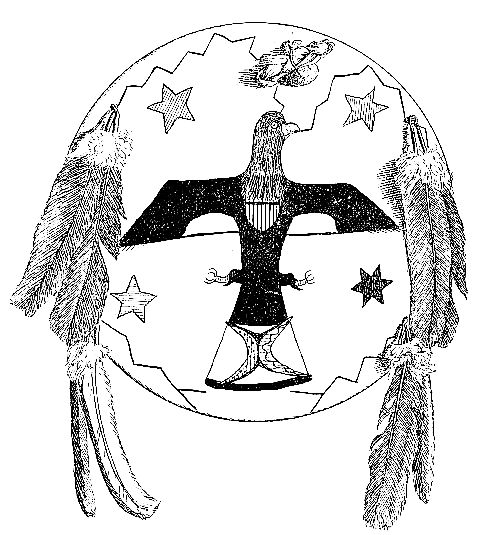
Fig. 1 (50-2970). Shield-cover with Design. Diameter, 42 cm.
Another shield-cover (Fig. 1) bears a bird-design, representing to the owner the osprey (?). One half of the background of this shield is in yellow; the other half, in light green.[4] These two colors represent the appearance of the sky at sunrise; the yellow corresponding to the region of the dawn, and the green to the dark sky above. The four stars symmetrically arranged are colored black for the night, yellow for the dawn, blue for the evening, and red for the day; or in other words the whole circle is represented. The design of the bird presents some interesting details. The lightning-symbols represent the death-dealing power conferred upon the owner of such a shield-design at the time of his dream. The red marks upon the breast of the bird, representing the national emblem of the United States, were interpreted by the owner as symbolizing such death-dealing power in contending with soldiers. The peculiar feature upon the tail of the bird represents an additional experience, and was added to the shield about the year 1867, after a successful engagement with the United States troops, in which the owner of the shield participated. According to his account, the design on the tail of the bird is the conventional symbol of the spider-web, but is used here to represent an experience preceding the above engagement. As the war-party were moving forward, they saw a strange appearance in the sky, which took the form of this symbol. The sight of it caused the war-party to scatter; and the interpretation placed upon this by the owner was, that its manifestation of supernatural power, which was to be conveyed to them, would cause their enemies to scatter in like confusion. During the confusion into which the party fell, the stars moved rapidly through the sky and the lightning flashed in all directions. This is represented by the four corners of the design. At the top of the shield is a braid of sweet-grass and a small buckskin bag containing medicines of a supposed charm-value. Before going into battle, some of this sweet-grass was to be burnt, and ritualistic songs pertaining to the shield were to be sung. This having been done, the shield was supposed to protect its owner from his enemies. Eight feathers, arranged in pairs, are attached to the shield, and their quills are painted to correspond to the parts of the background to which they are attached.
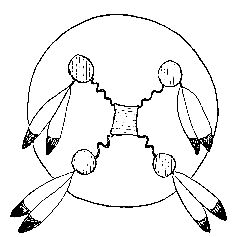
Fig. 2. Shield-design,
from a Drawing by a Native.
There is one interesting feature connected with this shield-design, and that is the fact that some of the old men disapproved of the owner placing the spider-web design upon the tail of the bird, because it was a mixing of supernatural manifestations. The incident connected with this design was regarded by them as most extraordinary, and as having been worthy of distinct and separate representation. According to the accepted modes of interpretation, this experience should have been represented upon a new shield.
The specimen shown in Plate vi is not a shield-cover, but was nevertheless spoken of as a shield; and the design upon it is an old shield-design. The specimen is a cape (made of cotton) worn around the shoulders in such a way that the design could be seen upon the back of the wearer. Here are represented the rainbow, the thunder-bird (possessing in this case characteristics which indicate that it was copied from the national emblem of the United States), the new and full moon, and the stars. It will be observed that the stars in this case are four-pointed, similar to the design of the spider-web, and they are regarded by the Indians as an example of the old original method of representing them.
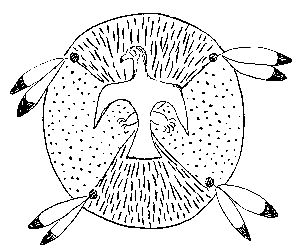
Fig. 3. Drawing, by a Native, of a Shield-cover.
As a great many Indians who formerly owned shields do not now possess shield-covers, the writer secured drawings made by them of their former shields. Such a sketch is reproduced in outline (Fig. 2). In the centre is a design of the spider-web filled in with red. The ground of the shield is in blue, representing the sky. Above and below are circular areas in yellow, representing clouds or heaven. Lightning-symbols in red connect the yellow cloud-symbols with the four corners of the spider-web design. As a final suggestion relative to this interpretation, the informant said, “The spider is the friend of the thunder.”
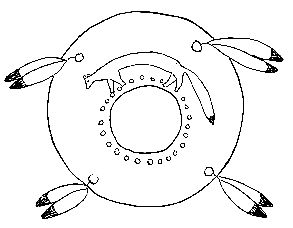
Fig. 4. Shield-design, from a Drawing by a Native.
The manner in which the owner secured the shield-design represented in Fig. 3 is as follows. Once when a war-party of which he was a member were about to take the war-path, it was predicted by an old man that he would be killed in the first battle. Before leaving with the party, he went to an old medicine-man for help, and this man made him a shield bearing the design described below. The bird represented is the hawk,—flying from the sky, protected by the thunder from the hailstones that fly thick and fast about him,—and symbolizes the manner in which the owner of the shield will pass safely through the hail of lead from the enemy. Four pairs of hawk-feathers are arranged symmetrically on the circumference of the shield.
In the shield-design in Fig. 4, we find a large circular area in the centre painted yellow and the surrounding portion red. Around the circumference of the yellow portion are black spots, representing tufts of short crow-feathers. Upon the original shield, across the top, there was tied the skin of a weasel, represented in the drawing by a pictograph of that animal. Four pairs of feathers are arranged symmetrically on the circumference of this design.
The design represented by Fig. 5 is rather striking, since an image of the spider is placed in the centre of the shield surrounded by a circle of red, through which the numerous red lines radiate to the circumference of the design. These red lines represent the web of the spider. One end of a string is tied to the mouth of the spider, with an eagle-plume at the other end, painted yellow. Around the circumference of the design is a wavy blue line, representing water. The owner of this design received such a shield when a young man, and stated that he never understood why the medicine-man who made it for him placed the blue line around it, and for that reason he could not explain its significance.
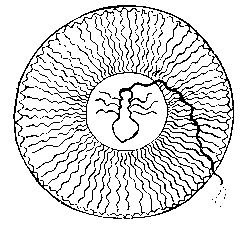
Fig. 5. Spider-design for a Shield, from a
Drawing by a Native.
The design represented in Fig. 6 was dreamed of by the owner himself, and in this dream he was presented with a shield bearing a design similar to the sketch. As he was almost blind, the sketch is very crude. In it appear again the thunder-bird, the stars, the yellow clouds, the red and blue lightning, the new moon, and the bear. It was claimed that the curved double line at the bottom represented both the moon and the lightning; the former by the colors, the latter by its form. Another interesting point in this design is the representation of an eagle-feather upon the head of the bear. This is the conventional way of representing a supernatural bear as distinguished from a real bear.[5] The owner of this shield-design claimed, that, while he did not now and had not for years carried or kept about him a drawing of the design, he felt it as a kind of magic presence hovering around him, shielding him from harm. He stated, further, that, while he knew that other men used the symbols represented in his shield-design as the signs of particular powers and ideas, he himself had no such interpretation; for in the dream he saw nothing more than a shield bearing these designs, and received no instruction or information as to their significance. Their protecting power to him lay in the peculiar supernatural presence which he always felt.
The shield-design in Fig. 7 represents a thunderstorm. At the top, the clouds are represented in blue. Below this, falling rain is represented by short irregular lines, and the lightning and thunder by zigzag lines extending downward from the clouds on a background of clear sky. This design originated in the same manner as did the preceding; that is, a finished shield was seen in a dream.
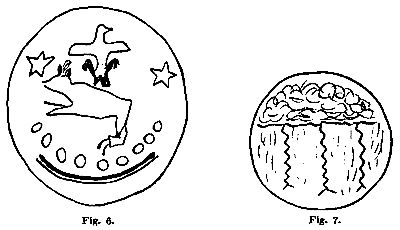
Fig. 6. Shield-design, from a Drawing by the Man who dreamed of it.
Fig. 7. Shield-design representing a Thunderstorm, from a Drawing by a Native.
Plate vii is the reproduction of a model of a shield made of shrunken bull-hide covered with buckskin. It was collected by Dr. J. R. Walker. The design is somewhat similar to the preceding. The upper part is painted in blue to represent the clouds, and the lower part in bluish-green to represent the sky. In the cloud-area is the drawing of a horse, symbolizing a dream-horse (probably the thunder-horse). The thunder, or power, is symbolized by red zigzag lines extending downward from the cloud-area. An eagle-feather and twelve hawk-feathers are tied to a small buckskin bag of medicine, fastened to the shield in a manner suggesting their attachment to the mane of the horse. The circumference of the shield is decorated with small feathers, and four pairs of eagle-feathers are also arranged symmetrically around the circumference.
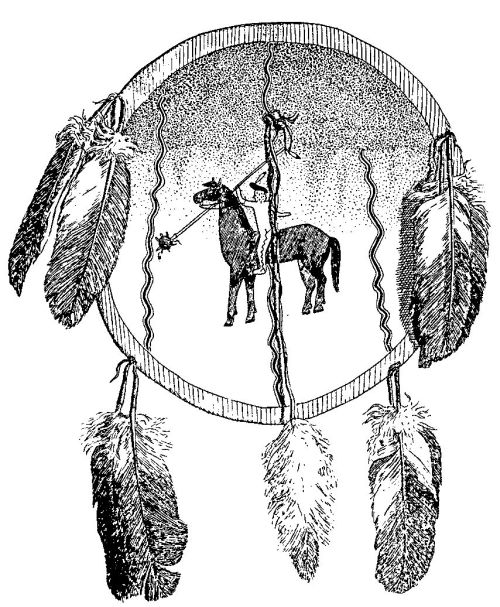
Fig. 8 (50-5456). Model of a Shield
with Pictographic Design. Diameter, 47 cm.
A shield (Fig. 8) similar to the preceding represents a vision in which the dreamer was apparently supported by the thunder-horse in a contest with the mythical turtle. A small bag of medicine and a pendant eagle-plume are attached to the shield, as in the previous case. Feathers are again arranged in four pairs. This specimen was collected by Dr. J. R. Walker.
In the Museum collection from the Sauk and Fox Indians, made by Dr. William Jones, is a shield captured from the Sioux, at the time of the outbreak of 1866, by a Fox in the employ of the United States Government. The design was painted upon the rawhide, but is now almost obliterated. Fig. 9 is a diagrammatic restoration. The writer saw an old buffalo-hide shield in the possession of an Assiniboine, at Fort Belknap, Montana. The design was painted upon buffalo-hide, and was similar to that in Fig. 9. He collected also from the Dakota a number of drawings representing military exploits. While twenty shields are represented in these drawings, fourteen of them bear simple circular designs, as shown in the adjoining figure. This suggests that the older type of shield-decoration made use of simple circular designs. This idea was supported by the testimony of a number of old men who ought to be competent to speak upon the subject. Of course, there is no reason why the image of the thunder-bird, so common upon modern shield-designs, should not have been used in ancient times; and the writer wishes to be understood as expressing this as an opinion based upon indirect evidence.

Fig. 9 (50-3569). Design on Sioux
Shield captured by a Fox Indian.
Diameter, 42 cm.
These circular designs often represented the sun, other heavenly bodies, or the sky, which suggests that formerly the shield as a whole may have been considered as a symbol of the sun. The survivors of shield-using days seemed to have no actual knowledge of any connection between the shield-form and the sun, but usually expressed it as their opinion that it represented the sun, and that the feathers represented the sun’s rays. This may have been suggested by the fact that eagle-feathers were sometimes arranged in a half-circle to represent the rays of the sun, and that, furthermore, the rays of the sun were sometimes spoken of as feathers.
Shield-designs could originate only in dreams and visions, and were painted by the person experiencing them, who prayed and sang over his work to give the shield power. Usually but four shields could be made from a single dream: to make a great number was sacrilege. Among the Blackfoot, the shield was often accompanied by a ritual composed of songs and prayers; and they possessed a few shields with such important rituals that they were distinguished from the others as “medicine-shields.” There seems to have been a similar condition among the Dakota, for it was often said that medicine-shields were hung outside the tepees, upon tripods, and that during the day they were changed from time to time so as to keep them facing the sun. This practice was observed by a number of Plains tribes. However, among the Dakota the tripod often gave place to a single pole.
|
Bandelier (Reports of the Peabody Museum, Vol. II, p. 109). |
|
Bandelier, op. cit., p. 108. |
|
In the drawings, colors are indicated by the following devices: red, by horizontal shading; yellow, by vertical shading; green, by left oblique shading; blue or purple, by right oblique shading. Black and white have their conventional qualities. The drawings were made by Miss R. B. Howe. |
|
For an illustration see Catlin, North American Indians (7th ed., 1848), Plate 102. |
About the year 1890 a religious movement, generally known as the “ghost-dance religion,” infected the Plains Indians. The chief feature of this religion was the belief in a speedy return of the old time, the buffalo, and the extermination of the white race. The different tribes had various ideas of their duties with respect to this new faith, and, with the exception of the Dakota, they did not manifest direct hostility to the white race. This warlike people, however, were already greatly dissatisfied with the treatment they received from the Government and with the difficult conditions under which they lived. In consequence, they received the ghost-dance religion as a herald of the good time which, to their minds, was to be secured only by war with the white race. While a great many of the conditions in the immediate environment of the Dakota have been given by various writers as causes for the outbreak, the fact that these Indians interpreted the new religion as the manifestation of a warlike spirit was probably due to the fact that they were at heart a warlike people. Their ideas still run toward military things. As the essential idea of the ghost-dance religion was a return of the old time, the ceremonies pertaining thereto made use of the typical objects and ideas of the past. In this, of course, they were not entirely consistent, since they did not discard the use of fire-arms, and did not actually resurrect bows, arrows, and shields. Yet, as a substitute for the protective power of the shield, they introduced garments bearing protective designs. These garments are generally known under the name of “ghost-shirts,” and at the time of the outbreak were spoken of by white people as “bullet-proof shirts.” The following are descriptions of these garments by eye-witnesses at the time of their first appearance:—
“All the men and women made holy shirts and dresses they wear in dance. The persons dropped in dance would all lie in great dust the dancing make. They paint the white muslins they made holy dresses and shirts out of with blue across the back, and alongside of this is a line of yellow paint. They also paint in the front part of the shirts and dresses. A picture of an eagle is made on the back of all the shirts and dresses. On the shoulders and on the sleeves they tied eagle-feathers. They said that the bullets will not go through these shirts and dresses, so they all have these dresses for war. Their enemies’ weapon will not go through these dresses. The ghost-dancers all have to wear eagle-feather on head.”[6]
“I think they wore the ghost-shirt or ghost-dress for the first time that day. I noticed that these were all new, and were worn by about seventy men and forty women. The wife of a man called Return-from-scout had seen in a vision that her friends all wore a similar robe, and on reviving from her trance she called the women together, and they made a great number of the sacred garments. They were of white cotton cloth. The women’s dress was cut like their ordinary dress, a loose robe with wide, flowing sleeves, painted blue in the neck, in the shape of a three-cornered handkerchief, with moon, stars, birds, etc., interspersed with real feathers, painted on the waist and sleeves.
“The ghost-shirt for the men was made of the same material—shirts and leggings painted in red. Some of the leggings were painted in stripes running up and down, others running around. The shirt was painted blue around the neck, and the whole garment was fantastically sprinkled with figures of birds, bows and arrows, sun, moon, and stars, and everything they saw in nature. Down the outside of the sleeve were rows of feathers tied by the quill-ends and left to fly in the breeze, and also a row around the neck and up and down outside of the leggings. I noticed that a number had stuffed birds, squirrel-heads, etc., tied in their long hair. The faces of all were painted red with a black half-moon on the forehead or on one cheek.”[7]

Fig. 10 (50-3053). Front of a Ghost-dance Garment.
Length, 126 cm.
As is noted by the above, designs on these garments were made by individuals who had dreams or other unusual experiences similar to those of the medicine-men; and it would seem from this account that the designs and objects used in the dance were in every way similar to those employed before the ghost-dance religion appeared. The writer made the acquaintance of several individuals who had prepared such garments at the time of the ghost-dance, and from them he secured reproductions with explanations as to the significance of the designs. As some time had elapsed since the ghost-dance religion was at the height of its popularity, it is possible that the more special features belonging to it were forgotten by these men, and that they worked into the reproduced garments older and more conservative ideas. However, the writer is of the opinion, and he took special pains to investigate as best he could, that whatever may have been lost in this way made no important changes in either the objective character of the designs or in the ideas expressed by them. As a matter of fact, the ghost-dance in some of its milder forms is still observed.
Some garments secured by the writer are decorated on both front and back with designs chiefly pictographic. On the front of one (Fig. 10) is a large triangular space extending downward from the shoulders (one half of which is in red and the other half in blue), thickly dotted over with white spots representing hailstones. The red represents the morning; and the blue, the night. Extending across from side to side is a large arched figure made up of red, yellow, white, and green bands, representing the rainbow. Above this are two four-pointed stars, the red for the morning star and the black for the stars seen in the night. There is a large green star with eight points on the dividing-line between day and night, concerning which I secured no satisfactory explanation. At the apex of the triangular space are small dots of yellow, representing the dawn; and the sun is placed on each side of the division between day and night. The new moon is represented by a black crescent. On the morning-side of this design is the picture of a butterfly; while on the night-side, extending over into the morning, is a picture of a peculiar figure, which the artist regarded as a spirit-bird or man-bird, as he expressed it, with the medicine-hoop in his hand. The other portion of the dress is covered over with small dots in various colors, representing bullets. There are also pictures of butterflies, stars, and buffalo-tracks. On one side are two parallel wavy red lines, and on the other two in green, representing the lightning.
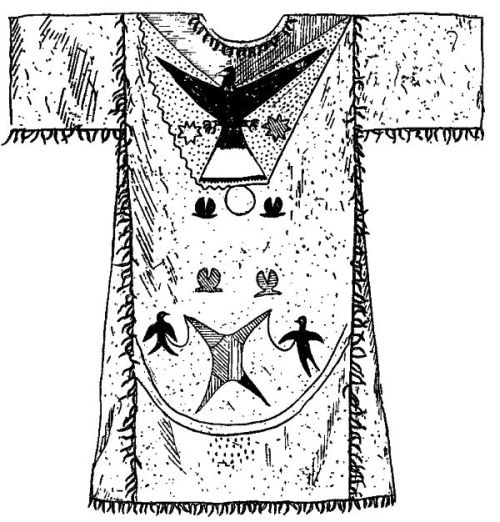
Fig. 11 (50-3053). Back of Garment
shown in Fig. 10.
On the other side of this garment, or the back (Fig. 11), is the representation of a bird, which seems to be mythical rather than realistic. The background upon which the figure rests is dotted to represent bullets or hail, as both have the same significance. The lower part of the garment is the most interesting. Here we have four buffalo-tracks arranged in rectangular relation to represent buffalo, and a circle or medicine-hoop (half of which is red and half green) with extending lines of the same colors, representing the thunder, or its power. The idea of this association of the hoop, or, as it is sometimes spoken of, the mirror, is that this buffalo escapes bullets, or perhaps is immortal. Below the sign of the buffalo is a four-pointed figure, usually known as the spider-web design, representing the heavens; and below this is the rainbow. Two swallows are represented connected to the points in the spider-web design by lines, indicating that they enjoy the protection of this power, making them difficult to hit with bullets or other missiles.
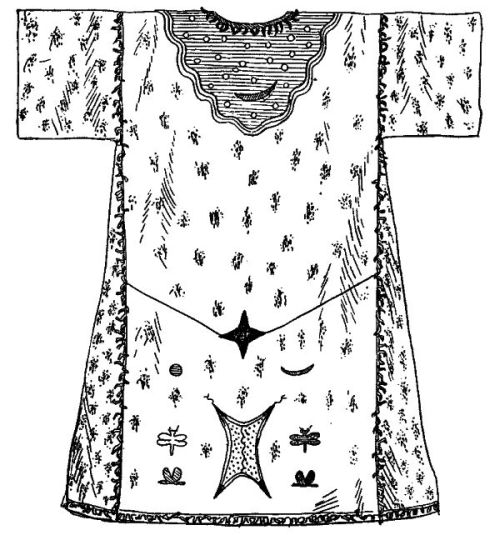
Fig. 12 (50-3054). Designs on the Front of
Ghost-dance Garment. Length, 128 cm.
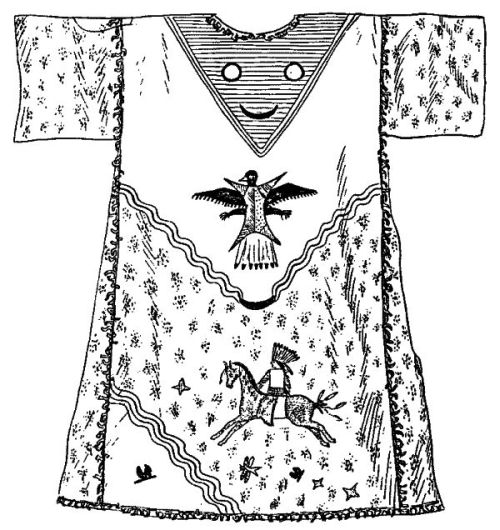
Fig. 13 (50-3054). Designs on the Back
of Garment shown in Fig. 12.
On another garment (Fig. 12), the triangular area at the top is entirely in red, covered with white spots representing hail, and bordered with wavy lines representing the rainbow. This represents the rainbow in the sky. The dark crescent represents the moon. Below is a large four-pointed star in black, representing the night, with a line extending over each side, representing the clouds. The small disk in red represents a bullet; and the small green crescent, the moon. Below these is the spider-web design, representing the heavens, over the four corners of which the lightning appears; but in this case the design is covered with dots representing the falling of the stars. Near this design we find the butterfly and the buffalo-tracks. The remaining space on the whole garment is covered with patches of color, representing the hail. On the opposite side (Fig. 13) are peculiar triangular designs, the background of which is in red bordered by straight lines, suggesting the rainbow; while on the red background are placed the design of the moon and two circles in such relation as to suggest a face. This design was spoken of as the “moon-face;” but this seems to have been an after-interpretation, since the artist wished to represent the medicine-hoop or mirror in the sky. [It seems likely that this is simply an adaptation of a head-dress used in the elk ceremony.] Below this we have a combination which appears to be the spider-web design combined with the figure of a bird, which is said to be the dream-figure, representing the bird seen on a tree. Below this we have the moon, rainbow, tracks of the buffalo, stars, butterfly, and a mounted warrior riding through the hail.
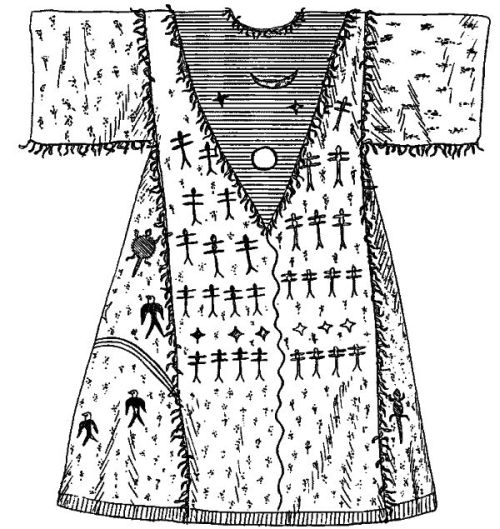
Fig. 14 (50-3055). Front of a Ghost-dance Garment
bearing Dragon-fly Design. Length, 125 cm.
In Fig. 14, the triangular space at the top is similar to that on the preceding garment, and need not be described here. The body of the dress is covered with dragon-flies as they appear when flying over water. The stars represent reflections in the water; and the dashes of color, the hail. The wavy green lines extending down the full length of the garment represent the lightning. In this case the red at the top is spoken of as the thunder-cloud. On the opposite side (Fig. 15), the triangular area with its tail-like extension represents the rattlesnake. In addition we have tracks of the buffalo dragon-fly, and butterfly, all associated as in nature. Upon the sides of this garment are the designs of the lizard, swallow, and turtle.
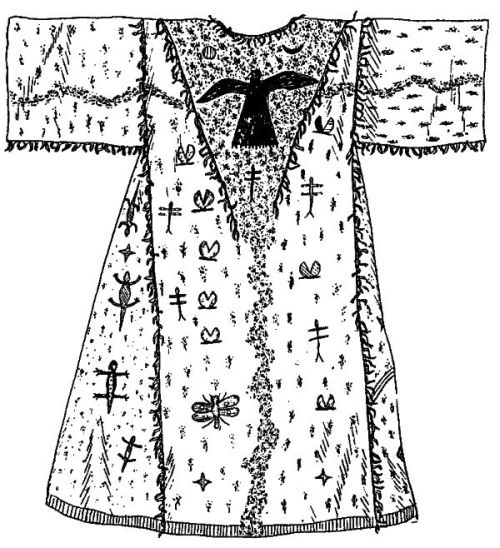
Fig. 15 (50-3055). Back of Garment shown in Fig. 14.
The above detailed statements concerning the designs and their import do not convey their full significance as it was brought out in discussions between the writer and the men who made these garments. In the first place we find on them symbols to be described in another section of this paper; namely, the spider-web designs and the medicine-hoop. It will be seen that in most cases the living creatures represented are those that seem to have power to escape the hailstones, because, as they say, no matter how severe the hailstorm may be, no one observes their dead or maimed upon the ground: therefore they assume that these creatures possess some extraordinary power, or receive the attention of some protective power. The bird represented does not seem to be the thunder-bird, as is usually the case in Dakota art, but such species, usually birds of prey, as soar above the destructive range of the hail. The lizard and the turtle are spoken of as animals of great power, since they are killed with great difficulty, from which it follows that they also enjoy the protection of some power. This we may generalize by saying that the Indian placed upon these garments representations of living creatures that, according to his observation and experience, were seldom hit by missiles, or that possessed great vitality, making it difficult to kill them. Placed on the garments, they express a prayer, a hope, or an actual realization, on the part of the wearer, of the protective power by which these creatures are enabled to survive.
The triangular designs at the top of these garments were spoken of as shields, the idea being that they were in some measure shield-designs, and performed the same function as did those upon shields in former times. Mr. Mooney expresses the opinion that the protective designs on garments used in the ghost-dance religion were not aboriginal with the Indian.
“The protective idea in connection with the ghost-shirt does not seem to be aboriginal. The Indian warrior habitually went into battle naked above the waist. His protecting ‘medicine’ was a feather, a tiny bag of some sacred powder, the claw of an animal, the head of a bird, or some other small object which could be readily twisted into his hair or hidden between the covers of his shield, without attracting attention. Its virtue depended entirely on the ceremony of the consecration, and not on size or texture. The war-paint had the same magic power of protection. To cover the body in battle was not in accordance with Indian usage, which demanded that the warrior should be as free and unincumbered in movement as possible. The so-called ‘war-shirt’ was worn chiefly in ceremonial dress-parades, and only rarely on the war-path.”[8]
This statement, however, suggests that Mr. Mooney based his opinion upon objective evidence, while the opinion expressed by the writer is based upon subjective evidence. A comparison of the interpretations of shield-designs and ghost-dress designs seems to leave little opportunity for any other conclusion than that the protective designs used in the ghost-dance were essentially the same as those used in former times upon shields and other objects. The garments may be foreign; but the idea of protective designs is most certainly not peculiar to the ghost-dance religion, since it was widely distributed among American tribes, and associated with ceremonial objects that were in use at least a century before the ghost-dance religion appeared.
If the writer had no other information at hand than that furnished by Mr. Mooney in his comprehensive study of the ghost-dance religion, he would be inclined to regard the whole as the manifestation of aboriginal religious ideas in response to a single foreign conception; namely, that of the coming of a messiah and the destruction of the present order of the world. The way in which the ghost-dance ceremonies were performed, the ideas expressed in the songs, the things the priests dreamed of, and the objects used in the ceremonies, are so characteristically Indian, that no other interpretation seems possible. However, in the present connection we are concerned with these designs as types of the universal primitive expression of belief in the presence of a guiding personal agency that looks into the affairs of men.
|
George Sword, on Ghost-dance Religion (Fourteenth Annual Report of the Bureau of American Ethnology, p. 798). |
|
Mrs. Z. A. Parker (Fourteenth Annual Report of the Bureau of American Ethnology, p. 916). |
|
Mooney (Fourteenth Annual Report of the Bureau of American Ethnology, p. 790). |
The circle, or more properly the hoop, is a very important religious symbol among the Dakota. One form of it appears in the great hoop-game described by Louis Meeker,[9] and later by Dr. J. R. Walker.[10] This hoop is usually about two feet in diameter, and notched so as to divide the circumference into quadrants. While this hoop-game seems to be a true gambling game, it could be and was sometimes played as part of a ritualistic ceremony the object of which was to bring the buffalo. It is interesting to note that this large hoop is similar to the sacred wheel used by the Arapaho in the sun-dance. At the time of the ghost-dance outbreak among the Dakota of Pine Ridge Reservation, Mr. Mooney saw the hoop and the two pairs of sticks used with it carried in the ceremonies connected with the ghost-dance religion. He states:—
“It is said that the medicine-man of Big Foot’s band carried such a hoop with him in their flight from the north, and displayed it in every dance held by the band until the fatal day of Wounded Knee. A similar hoop was carried and hung upon the centre tree at the dance at No Water’s camp near Pine Ridge. To the Indian it symbolizes the revival of the old-time games.”[11]
The last line of the above quotation implies that the hoop was a part of the paraphernalia used in the ghost-dance ceremonies, because it symbolized the ancient games. On another page of the same article occurs the following:—
“As it was the favorite game with the men in the olden times, a great many of the songs founded on these trance visions refer to it, and the wheel and sticks are made by the dreamer, and carried in the dance as they sing.”[12]
It should be remembered, however, that the game was formerly played to restore the buffalo when they were temporarily absent from their range; and, as one of the great objects of the ghost-dance religion was the return of the buffalo as in the olden times, the reason for the use of the hoop in the ceremonies described by Mooney is apparent. In Mooney’s account, a number of songs pertaining to the hoop-game are given as sung by the various tribes practising the ghost-dance religion. Among these is a Dakota version, as follows:—
| “The holy (hoop) shall run, | “Come and see it, |
| The holy (hoop) shall run, | Come and see it, |
| The swift hoop shall run, | Says the father, |
| The swift hoop shall run.” | Says the father.”[13] |
A mythical account of the hoop-game is given by Dr. J. R. Walker, which indicates one of the probable conceptions upon which this religious use of the hoop rests.[14]
The hoop-symbol occurs in graphic form, sometimes upon garments. The writer secured a shirt that was used by one of the leaders in ghost-dances; and which seems to have been a type of the so-called “bullet-proof shirt.” This garment is daubed with red about the neck and on the shoulders, but in addition bears four circular designs, also in red, with large dots at their centres (Fig. 16). One of these designs is placed upon the right breast; another, directly opposite, upon the back of the garment; one upon the right shoulder; and one upon the left. These are so arranged, that, no matter from what point you see the wearer, one of the circular designs will be visible. These designs were recognized as symbols of the medicine-hoop, and were supposed to have the power to protect the wearer from all harm. The idea of placing the designs so that one of them should always be between the wearer and the source of danger may be original with the owner of this shirt; but the number of them (four), and their arrangement according to the four directions, correspond to the common explanation of religious symbols.

Fig. 16 (50-2964). Circular
Design upon a Shirt.
Diameter, 11 cm.
Meeker describes[15] a wheel-shaped hoop-ornament consisting of a ring enclosing four spokes at right angles to each other. According to his account, this is a symbol associated with the hoop-game; but similar specimens were seen by the writer upon the heads of Dakota men, who explained that these were symbols of the medicine-wheel or medicine-hoop, and did not refer to the hoop-game. They were worn because they were regarded as symbols of the power that could protect the wearer from arrows, bullets, or other dangers.
As is suggested by the above, the game-hoop is distinguished from the medicine-hoop as used in ceremonies. A medicine-hoop seems to have been used by all divisions of the Dakota, and, according to the descriptions received by the writer, to have been of several forms. In certain ceremonies where the elk played an important part, a hoop or ring was formed by twining together fresh twigs and leaves of the willow. In the centre of this hoop, a small mirror was held by four cords arranged at right angles, and representing the four directions. A drawing of an elk-dancer by a native is shown in Fig. 17. The painted centre for the circular designs on a shirt (Fig. 16) described above, as well as the small wheel-shaped head-ornament, were said to represent a hoop of this type.
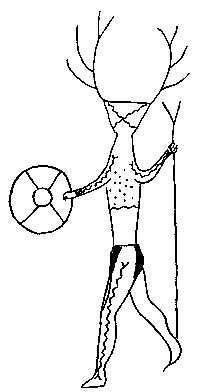
Fig. 17. Sketch, by a Native,
of an Elk-mystery Dancer carrying a
Hoop with a Mirror in the Centre.
Drawing collected by R. Cronau.
The connection of this hoop with the idea of protection is well illustrated in the manufacture of one kind of red paint. It is produced by burning a kind of yellow clay, found near the Black Hills, until it takes on the red color. The paint, however, is given its protective power by certain ceremonies performed as it is made. In the particular ceremony observed by the writer, the yellow earth was pounded fine, and mixed with water until it became a stiff paste. This was then made into a flat disk about half an inch thick and from four to six inches in diameter, after which a hole or depression was made in the centre. The purpose of this, as explained, was to give it the form of a medicine-hoop, the hole in the centre corresponding to the place occupied by the mirror in the form of hoop just described. This disk was then burned in the fire until red, after which it was pounded on a stone until fine enough for use. The ceremony in preparing the paint consisted of ritualistic songs and prayers, which reached their climax as the disk of clay was formed and perforated. The burning and the subsequent preparation were not regarded as parts of the ceremony. The idea, as expressed, was to connect the paint with the power represented by the hoop, so that when a warrior rubbed some of it upon his body, he came at once under the protection of this power.
Another idea seems to be connected with the conception of the medicine-hoop, and that is the appearance of certain mythical animals with openings through their bodies where their hearts should be. The conception seems to be, that an animal without a heart is immortal and supernatural: at least, this is the way in which the mythical elk was described. According to the belief, there is a connection between this opening through the heart and the centre of the medicine-hoop, represented in the elk ceremonies by the mirror; but it is the opinion of the writer that this is an error on the part of the Indians themselves in associating two things that were formerly distinct.[16]
It seems rather curious that the mirror should become so closely associated with the hoop, and that the mirror should have appealed to them as a symbol of almost equal importance. The writer is of the opinion that the preceding cases, where the mirror and the hoop are considered as identical symbols, are the result of a former close association of the two in ceremonial affairs.
|
Meeker (Bulletin of the Free Museum of Science and Art, University of Pennsylvania, Vol. III. No. 1). |
|
Walker (The Journal of the American Folk-Lore Society, October-December, 1905). |
|
Mooney (Fourteenth Annual Report of the Bureau of American Ethnology, p. 1075). |
|
Mooney (Fourteenth Annual Report of the Bureau of American Ethnology, p. 994). |
|
Mooney (Fourteenth Annual Report of the Bureau of American Ethnology, p. 1075). |
|
Walker (The Journal of the American Folk-Lore Society, October-December, 1905). |
|
Meeker, op. cit., p. 35. |
|
In the Report of the Peabody Museum (Vol. III, p. 286) is a description by Miss Fletcher of some ceremonies in which the hoop and the mirror played a part. “The neophyte held one, having a circular mirror, fastened by four cords, from which he cast a reflection of the sun from time to time upon the ground, or held up the hoop, and flashed the mirror.” The explanation given by this author of the significance of the mirror in these ceremonies differs from that secured by the writer; but Miss Fletcher’s account seems to refer to a form of ceremony pertaining to the elk rites not mentioned in his notes. |
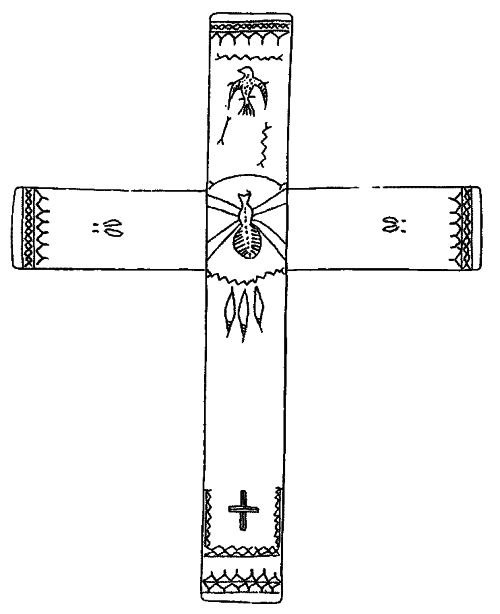
Fig. 18 (50-2095). Engraved Metal Cross.
Collected by R. Cronau. Length, 23 cm.

Fig. 19 (50-2898). Engraved Bone Object.
Collected by R. Cronau. Length, 24 cm.
In another place the writer has described the conception of the power of the whirlwind among some of the Dakota, but wishes at this time to refer to it again because of its relation to their system of protective designs.[17] As stated in the former publication, there seems to be in the minds of some of the Dakota an association between the phenomenon of the whirlwind and those mental states generally known as “confusion of mind.” Some of them believed and still believe that the power in the whirlwind can be invoked to confuse the mind of an enemy. In common with many other American tribes, the Dakota believe the whirlwind to be associated with the fluttering wings of a moth, but they also associate this with the cocoon of the same moth; and in symbolic representation the design representing the power of the whirlwind is of an elongated diamond-shape, and refers to the cocoon. The protection or aid of the whirlwind was secured by prayers, and these prayers were symbolized by the cocoon worn upon the person, by its image in stuffed buckskin, or by its graphic representation, sketched or painted. The power of the whirlwind was supposed to have been associated with the power of the spider-web. As an illustration of this, we find engraved upon a German-silver cross (Fig. 18) the spider, and near it three representations of the whirlwind cocoon. Between the spider and these three designs is a zigzag line, implying the mystic power connection of the same. Again, on a forked bone object (Fig. 19), the use of which is unknown, occur a number of incised designs, among which is again what seems to be the spider-web, the tracks of a quadruped (probably the buffalo), and four designs representing the whirlwind cocoon, accompanied in each case by another design which cannot be determined, but which resembles the footprints of a person. It is interesting to note that the German-silver cross also bears the tracks of the buffalo, or some ruminant animal, in association with the spider. In the absence of direct information, the writer hesitates to offer any interpretation of the design upon these specimens, although he feels that they could be interpreted with reasonable certainty.
The design of the whirlwind resembles a feather-design, and no doubt the two are often confused. The difference seems to be, that, when representing the whirlwind, half of the design is filled with parallel or crossing lines; while, when representing feathers, half of the design is filled in with color (see Fig. 19). The feather-design is more fixed in form than that of the whirlwind. Fig. 20 is a representation of the latter, from the handle of a club, where it appears in a series with the spider, lizard, elk, and turtle. Another form of the same design is repeated in a series on a wooden popgun (Fig. 21).

Fig. 20 (50-4380). Whirlwind Design, from the Handle of a Club. Length, 5 cm.
Fig. 21 (50-4244). Whirlwind Design, from a Popgun. Length of design, 7.5 cm.
|
Wissler (The Journal of the American Folk-Lore Society, October-December, 1905). |
The thunder is a very important deity among all the Indians of the Plains, and is usually associated with military exploits. While the Dakota generally regard the thunder as a bird, usually symbolized by the eagle, yet they sometimes speak of it as a horse, a man, or a dog. The horse always appealed to them as a creature of mysterious origin, and in many cases was assumed to have been given by the thunder. In any event there is an association in their minds between the power of a war-horse and the thunder. The thunder is often represented by a zigzag or wavy line, usually in red; but this symbol really represents the power of the phenomenon in the abstract, because the Indian does have the conception of a force in nature. Consequently this graphic symbol is also a general sign for the presence of mysterious supernatural power. The whistles made from the leg and wing bones of eagles, and used among the Plains tribes, are generally employed by the Dakota to symbolize the cry of the eagle as a representative of the thunder-bird. In battle, or sometimes in stress of great trial, they are sounded to call up the power of the thunder to rescue the unfortunate one. As a rule, a zigzag line is scratched down the sides of these whistles. In this connection it is interesting to note the following:—
“Before daylight I set off with five Indians. . . . This caused a halt, as we were surrounded and began to suspect that the enemy had planned to cut us off. The Indians put on their war-caps, uttering some few words which I could not hear distinctly, and then began to whistle with a small bone instrument which they hung around their necks for that purpose.”[18]
This account (1807) by an acute observer is interesting, because our present knowledge enables us to understand the muttered prayers and the use of the whistle.
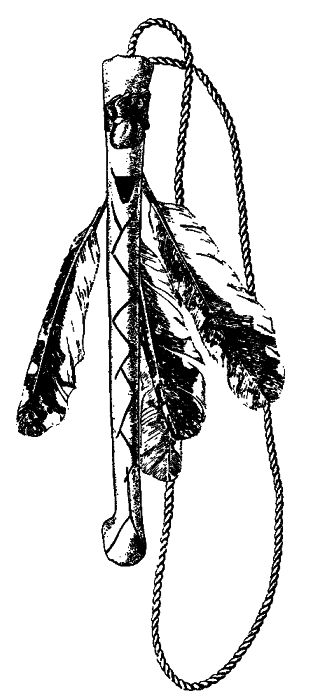
Fig. 22 (50-3023). Whistle, of Bone.
Length, 19 cm.
The whistle shown in Fig. 22 is interesting because of the objects that accompany it. The whistle is from the wing-bone of an eagle, and near the top is a small bag containing the medicine of the owner. The feathers of the yellow-winged woodpecker are attached thereto, because this bird is considered as an associate of the thunder-bird, or at least it holds some relation to the thunder, since the Dakota have observed, that, when a storm is approaching, this bird gives a peculiar shrill call not unlike the sound of the whistle spoken of above. This they interpret as speaking to the thunder. Consequently, the feathers of this bird, when attached to the whistle, are supposed to put the individual also in a position to speak to the thunder. This bird has a large dark spot on the throat, which is said to represent the moon and to be further evidence of the sacred character of the bird. Thus we have a combined charm representing the woodpecker and the eagle,—two birds closely associated with the thunder.
The ceremony of offering a filled pipe to the thunder was frequently observed by the Dakota. One man stated that once, when the camp was threatened by an approaching storm, he filled a large pipe, went to the top of a hill, and, facing the storm, made an offering to the thunder by extending the stem upward, and praying, with the result that the storm divided, and passed around the camp without serious damage to his people. In the decoration of pipe-stems, a bunch of horsehair is attached (usually colored red), and this is often spoken of as an emblem of the thunder-horse. This horsehair is to signify the presence of the power of the thunder, as manifest in the horse, in all ceremonies connected with the pipe. It is worth while noting that in this case we have an illustration of a peculiarity of religious lore,—the indirect symbolizing of a power by one of a series of objects in which that power is manifest.
The United States emblem of the eagle with outstretched claws, holding arrows and the lightning, is regarded by the Dakota as an appeal on our part to the thunder-bird; and statements to the contrary are usually interpreted as white men’s lies to deceive the Indians and to guard the power. There is little doubt that the Dakota manner of drawing the thunder-bird has been modified by the United States emblem, and that their own idea of his power has been influenced accordingly.
|
New Light on the Early History of the Greater Northwest, p. 436. |
The association between the spider, the spider-web, and the thunder, is very close—so close, that it is difficult to understand the conception of the power of the spider without considering the power of the thunder. The spider is often spoken of as the “spider-man.” It is also associated with the mythical elk. It was supposed to have great power. The observed fact that a spider manufactures a web, and that this web is not destroyed by bullets or arrows (since they pass through it, leaving only a hole), is cited by some individuals as the basis for the conception that the spider has power to protect people from harm. On the other hand, the spider is spoken of as a friend of the thunder; and it is a general belief that the thunder will never harm the spider-web, or, what amounts to the same, that the spider-web itself is a protection against thunder. As previously stated, the spider-web is represented by a peculiar four-cornered design. This design is sometimes said to represent the heavens, in which case the four points represent the four directions, the home of the winds, the four thunders, etc.; the supernatural character of the design being indicated by lightning-symbols extending from the four corners.
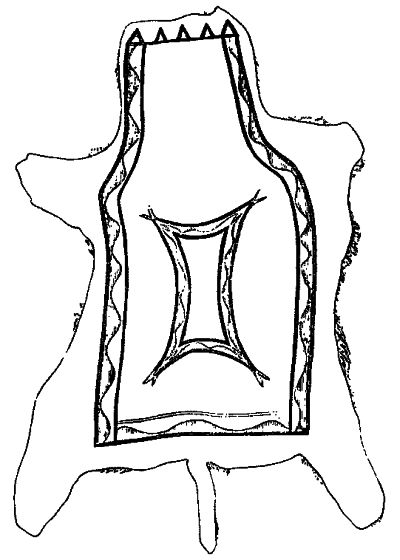
Fig. 23 (50-3095). Design of a Spider-web.
In a preceding paper,[19] the spider-web design was discussed in its relation to decorative art, where it was noted that among some divisions of the Dakota is a belief in a double woman,[20] to whom, among other things, certain ceremonial uses of this design are attributed. According to information secured by the writer, this character was also associated with the elk ceremonies, where she was often represented by two women tied together by a cord (about two feet in length), from the middle of which hung a doll or a ball. Women often receive power by dreaming of this character. Some such women are supposed to perform a kind of ceremony, somewhat secret, in which a child is taken out to a lonely place, where a swing or hammock-like structure is made in the form of the spider-web design, supported by the four corners, and the child is placed upon it. This is to bring good fortune to the child. A design of the spider-web might then be placed upon the robe of the child as a symbol of its having experienced the ceremony (Fig. 23).
The men, however, use this design for military protection, in which connection it is not thought of as being associated in any way with the mythical double woman. It is, however, closely associated with the medicine-bow. This was a very sacred military object with the Dakota, of which only four duplicates could be had. It consisted of a bow of plain wood, of the usual length, to the end of which was attached a spear-head. Fastened to the bow was a stick somewhat longer, sharpened at one end, and decorated with feathers and other symbolic objects. The purpose of the stick was to support the bow, since all such sacred objects would lose their power if allowed to touch the ground. The bow was not used as a weapon, but was carried as a standard, because of its supposed magical power over the enemy. The figure of the dragon-fly was usually painted upon the bow and its support, as well as dots representing insects that fly swiftly, and zigzag lines representing thunder. Feathers of the eagle, the magpie, the hawk, and, in fact, of all birds swift of wing, were likewise attached to it. The association between these insects and birds was the same as that previously noted; that is, since they were swift in motion, and difficult to strike, they represented the qualities desired by the bearers of the bow. These bows have long since passed out of existence, but survive in models made for commercial purposes.
The account of the origin of the medicine-bow is as follows:—
“A man dreamed of the thunder, and afterwards called in four men to assist him in making the medicine-bow. They went through the preliminaries (the sweat-house, etc.), after which a special tent was erected. The ground inside of this tent, where the dreamer and his four companions sat, was covered with sage-grass. A young man was called in to act as their assistant. He was sent out to cut elm sticks. He went out slowly, and after a time came back with the sticks. Then he was sent out to get together the feathers of swift flying birds, pieces of buffalo-hide, paints, etc. He went around the camp, and begged these of the people.
“Then the four men set to work making the sticks under the direction of the dreamer. The dreamer gave a bow to one of the men, and a piece of buffalo-hide in which to wrap the sticks, also a wooden bowl from which to eat.
“After a time, the faces of the men were painted red. When the sticks were finished, four men came in wrapped in buffalo-robes, each carrying a drum. Now the four men who had prepared the sticks were ready to receive the bow, and the drummers began to drum and sing. Then the man who dreamed about the bow carried it outside of the lodge, pointing it toward the west. He was followed by the whole company, and, after singing a song, they took a step forward and pointed the bow to the north; another step again, then pointed to the east; and then a step forward, pointing to the south. Then they ran toward the west, then toward the east, then toward the north, and then toward the south. [The significance of this is, that the thunder resides in the four directions of the heavens, and also goes in all directions, so that the carrying of the sticks toward the various points of the compass puts them in touch with the thunder.] Then they went back to the sweat-house, and the ceremony was complete.
“The man who owns one of these bows must not wear iron on his person, he must never give his food to any one else after eating from it himself, and he must never allow the bow, or any part of it, to touch the ground.”[21]
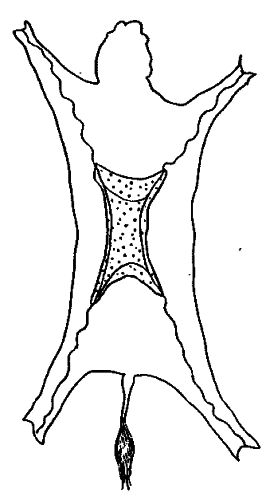
Fig. 24. Sketch of a Robe for the
Medicine-bow Owner. Drawn by a Native.
The owner of a medicine-bow should have a buffalo-robe with special decorations, consisting of a spider-web design of the character previously described, from the corners of which extend wavy lines representing the thunder. Sometimes the picture of a thunder-bird was drawn above the spider-web design, or a few tail-feathers of the eagle were attached to the robe. The spider-web design on the robe of an owner of a medicine-bow was to symbolize the thunder, for, as stated by the informants, the spider is a friend of the medicine-bow. None of these robes are now in existence; but sketches were made for the writer, one of which is reproduced in Fig. 24.
The body-painting for the medicine-bow was rather elaborate. In the first place, the whole body was smeared over with a brownish-red paint, representing the earth in a buffalo-wallow. There were two ways of decorating the face. In one, a curved line was drawn, extending from the corners of the mouth around over the forehead, the ends of the lines being forked to represent lightning. Wavy lines, also with forked ends, were drawn down the arms and the legs. These lines were in black or blue. Blue bands were painted around the ankles, arms, wrists, and shoulders, representing the power of the lightning. These bands were often covered with wristlets and anklets of rabbit-fur, because the rabbit was in some way associated with the medicine-bow. In the other painting, a crescent, representing the moon, was placed upon the forehead and a line drawn from ear to ear across the bridge of the nose. In this form, the body-painting was the same as in the preceding, except that one of the lines upon the leg was straight instead of wavy, and it was said to signify the desire for ability to think straight or to possess presence of mind, in contrast to the state of mind supposed to be produced by the power of the whirlwind.
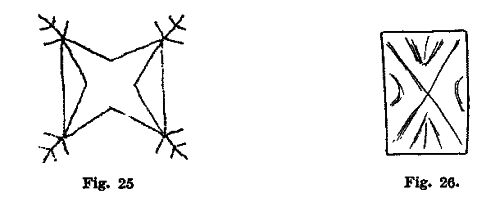
Fig. 25 (50-2093). Design on a Metal Belt-ornament. Width, 2 cm.
Fig. 26 (50-3124). Design of Spider-web on a Straight Pipe. Length, 25 cm.
The spider-web design has been mentioned in connection with shield and other designs, and a retrospect indicates a peculiar graphic resemblance in it to the older type of star-designs shown in Plate vi. The writer uses the term “older” on the authority of two Indians. Some incised designs on metal ornaments worn by a woman, of the form shown in Fig. 25, seem to be a combination of the older star-design and that of the spider-web. Another design (Fig. 26) scratched on the bowl of a straight pipe of red stone was also said to represent the spider-web. There is another design used by the Dakota in ceremonies relating to the buffalo; but it is rectangular in form with projecting corners, and is considered a distinct symbol.
|
Wissler (Bulletin of the American Museum of Natural History, Vol. XVII, p. 248). |
|
Dorsey (Eleventh Annual Report of the Bureau of Ethnology, p. 480). |
|
Narrated by an Ogalala man. |
The first point that appears in the consideration of these designs and their interpretations is the animistic basis upon which they rest. The Indian has observed nature, and singled out those qualities and situations that are not only wonderful from his point of view, but greatly to be desired as means to his own ends. He then proceeds on the assumption that these originate in and are due to some hidden agency, from which it follows, that, if he can put himself in the place of one of the favored living creatures, he will in turn be the object upon which this hidden agency will act. If he can be the bird that rides the storm in safety, he will in turn ride successfully the analogous storms of his own sphere, and, like the child that in its own mind is the policeman when it thrusts a club into its waistband, he feels that he is the bird calling to the thunder when he sounds the bone whistle, and mutters his song-prayer. That this is true only of the great Indian or the devotee, speaking in relative terms, and that the mass of Indian-kind follow in blind imitation of the more sensitive few, may be true; but the phenomena, for all that, are none the less ethnic.
One characteristic of the foregoing protective designs is, that they are usually animal motives to the almost entire exclusion of plant and inanimate forms. While it is true that the phenomena of the heavens hold a prominent place in this art, such phenomena are often interpreted as results of the activity of animal-like beings, and consequently are so expressed in art. The conditions leading to such a result are doubtless many and intricate; but the tendency to ignore plant-forms in protective conceptions may be due to the inactive character of the more inanimate world. Inert things are not easily conceived of as guardians or protectors. On the other hand, the Indian may not see the logical necessity of carrying his view to the utmost bounds of the universe. Pots and kettles may have an animistic presence within themselves; but perhaps this does not appeal to the Indian, because the living creatures are so much nearer to him and the analogy between their lives and his is not difficult to perceive. The mystery in the animal forms that come and go, in the storm, and in the heavenly bodies, reaches the mind unaided; but the plant and mineral wonders require a more microscopic eye. That there was a time when the animals were as the people is the striking thought in many Indian myths, and this indicates a belief in the fundamental life-identity of all moving creatures.
There is, however, one interesting suggestion in the interpretation of protective powers. In all of these conceptions we find less appeal for the direct destruction of enemies than for a shielding protection to enable the man himself to be the destructive agent. His prayers are, that he may be swift and impossible to hit in order that he may strike down the victim.
Again, there are in every part of the preceding paper examples of the close association between powers, or at least power-symbols, that are from many points of view incongruous; as the mirror and the hoop, the spider, the thunder, and the elk. There is in these a tendency to coalesce into conceptions of larger wholes in which the power becomes more general, tending toward the definite abstraction of a power-unit, or identity of forces in nature. These larger conceptions, that are really much more complex than indicated in this brief paper, seem to represent a growth, or at least an accumulation of ideas, on the part of a people who have not felt the need of systematically unifying them, or expressing them as an objective unit.

Anthrop. Pap. A. M. N. H. Vol. I, Plate v.
Model of a Shield.

Shield-design on a Cape.
Plate vi.

Anthrop. Pap. A. M. N. H. Vol. I, Plate vii.
Model of a Shield.
Misspelled words and printer errors have been corrected.
Punctuation has been maintained.
Some illustrations were moved to facilitate page layout.
[The end of Some Protective Designs of the Dakota, by Clark Wissler.]